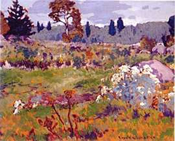FRANK JOHNSTON
1888 - 1949
 Frank
Johnston's official association with The group of Seven was brief,
but his friendship with the artists dated back over a much longer
period. As a commercial artist at Grip Ltd. he was involved with the
circle of young artists working there whose ideas about Canadian art
led to the formation of The Group. When he joined the firm around
1908 his fellow Grip workers included J.E.H. MacDonald and Tom Thomson,
and later Arthur Lismer and Franklin Carmichael signed on. Through
those men and as a member of the newly founded Arts and Letters Club,
he met other artists, including Lawren Harris - all painters with
new and exciting ambitions for Canadian art.
Frank
Johnston's official association with The group of Seven was brief,
but his friendship with the artists dated back over a much longer
period. As a commercial artist at Grip Ltd. he was involved with the
circle of young artists working there whose ideas about Canadian art
led to the formation of The Group. When he joined the firm around
1908 his fellow Grip workers included J.E.H. MacDonald and Tom Thomson,
and later Arthur Lismer and Franklin Carmichael signed on. Through
those men and as a member of the newly founded Arts and Letters Club,
he met other artists, including Lawren Harris - all painters with
new and exciting ambitions for Canadian art.
Johnston had much in common with these artists. Like them, in the years before World War I he used his spare time to pursue landscape painting, through sketching trips around Toronto and farther north to Bon Echo near Algonquin Park and to Hearst, north of Lake Superior - a source of inspiration for him. An eager participant in Group activities, Johnston went on all the Algoma trips except the last. Johnston did not use the techniques of Harris and MacDonald but, employing tempera rather than oil paint, he searched out the pattern and texture of his subject. The effect is more linear and decorative than that of his fellow artists, yet Johnston's paintings show the viewer the subtle colour relationships and interplay of forms in the foliage, rocks, and sky.
Johnston exhibited with The Group of Seven only once, in their first show at the Art Gallery of Toronto (now the Art Gallery of Ontario) in May 1920. A man of staggering energy and enthusiasm, Johnston had an amazing rate of production. In the 1919 Algoma show he contributed sixty works - more than any other artist. A few months later, he extended his independence even more, having a large one-man show of 200 paintings at the T. Eaton Company Galleries. In the fall of 1921, Johnston left Toronto to accept the position as principal of the School of Art in Winnipeg. There he held the largest show ever seen in that city. He had been slowly moving away from the Group movement, and now the break was complete. In 1924, he announced his official resignation, claiming that he had no disagreement with the group, only that he wanted to go his own way with regards to exhibitions.
 This
was in keeping with the character of this energetic, ambitious and
strong-willed man. When Johnston left The group, he turned more to
working for department store art galleries. Unfortunately, his work
lost his earlier fresh vitality and became more decorative. He was
a superb craftsman, but was mainly concerned with decorative effects,
which he constantly sought out.
This
was in keeping with the character of this energetic, ambitious and
strong-willed man. When Johnston left The group, he turned more to
working for department store art galleries. Unfortunately, his work
lost his earlier fresh vitality and became more decorative. He was
a superb craftsman, but was mainly concerned with decorative effects,
which he constantly sought out.
Johnston's style became increasingly realistic throughout his life, evincing a particular fascination for the qualities of light reflected from snow. This theme recurred in later works, in large narrative paintings of the 1930's and 1940's as well as more intimate examinations of a river valley, the bright blue of the water bending between snow-laden banks. His subjects range from the pastoral countryside of the Wyebridge area, northern Quebec, and the Northwest Territories. he had begun in the 1920's to hold regular solo exhibitions and his paintings found a great following among the public. Johnston achieved considerable financial success in his own lifetime.
Sources:
The National Gallery and 'The McMichael Collection'
Photograph: M.O. Hammond Collection, National Gallery of Canada Archives